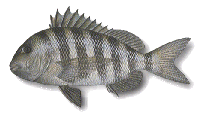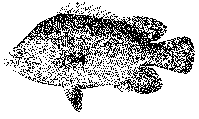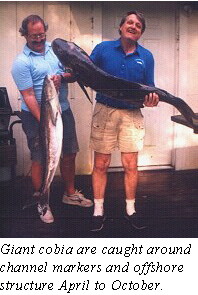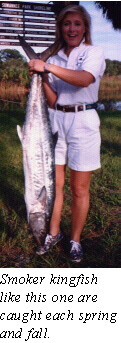 Spotted Seatrout
Spotted Seatrout Redfish
Redfish  Flounder
Flounder  Sheepshead
Sheepshead  Cobia
Cobia  Grouper
Grouper  Spanish Mackerel
Spanish Mackerel  King Mackerel
King Mackerel
 Spotted Seatrout
Spotted Seatrout
 Redfish
Redfish
 Flounder
Flounder
 Sheepshead
Sheepshead
 Cobia
Cobia
 Grouper
Grouper
 Spanish Mackerel
Spanish Mackerel
 King Mackerel
King Mackerel
 Dolphin
Dolphin  Bluefish
Bluefish Tripletail
TripletailGenerally, Big Bend fish are somewhat smaller (especially the flounder), but more abundant, than elsewhere in Florida. To win for the year in a "Big 8" category usually requires a seatrout over 5 lbs, a redfish over 40 inches long, a flounder of 3 to 4 lbs, a sheepshead over 10 lbs, cobia over 50 lbs, a grouper over 25 lbs, a spanish mackerel over 6 lbs, or a king mackerel over 30 lbs. Of the "Other 3," dolphin and bluefish are relatively small (just a few pounds), but tripletail may go over 20 lbs.
 January.
January.
The action really heats up in the spring. The grouper become more aggressive, spanish mackerel reappear, and a run of king mackerel passes through during April, followed closely by cobia. Seatrout move out of the creeks and rivers onto the grass flats, and even the reliable redfish seem to bite a little better. Flounder are scattered as always, and the big offshore sheepshead spawn quits in early April.
 Fishing is tough in the summer. The heat is brutal, and the action slows way
down for many species. Kingfish and grouper move far offshore. The spanish
mackerel are off and on, as are the seatrout. Redfish seem unaffected by the
heat, and big cobia cruise the grass flats and offshore structure all summer.
The lucky, and usually unprepared, angler may even encounter a tarpon, but
the best tarpon fishing is just south of Homossassa, beyond the GOFC
tournament limits. Because of the summer's heat, some Big Bend anglers
switch to cooler activities like recreational scalloping and shrimping during
July and August.
Fishing is tough in the summer. The heat is brutal, and the action slows way
down for many species. Kingfish and grouper move far offshore. The spanish
mackerel are off and on, as are the seatrout. Redfish seem unaffected by the
heat, and big cobia cruise the grass flats and offshore structure all summer.
The lucky, and usually unprepared, angler may even encounter a tarpon, but
the best tarpon fishing is just south of Homossassa, beyond the GOFC
tournament limits. Because of the summer's heat, some Big Bend anglers
switch to cooler activities like recreational scalloping and shrimping during
July and August.
Autumn is the best time to fish the Big Bend. Everything is bigger and hungrier. A terrific fall run of king mackerel passes through in October and may persist into November if the weather stays warm. The spanish mackerel and cobia put on a big bite before abruptly departing by the end of October. However, to fill the vacancy, hungry grouper move from their summer haunts far offshore to nearshore waters as shallow as 20 feet. In November and December some of the best trout and redfish action of the year appears in the tidal creeks, and even the elusive flounder becomes easier to catch.